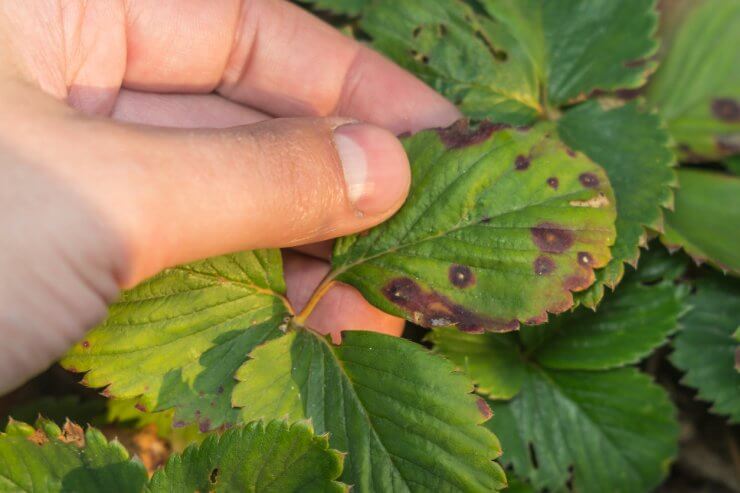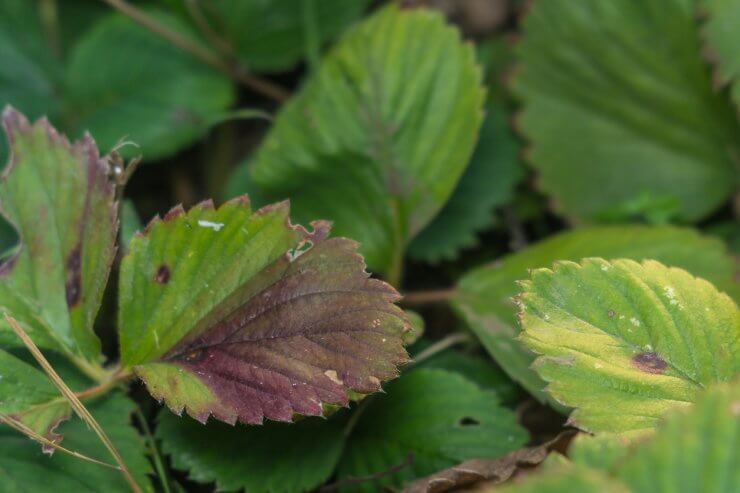
Diseased strawberry leaves
Like all food crops, strawberries are susceptible to various fungal diseases. Your best weapons against these are best planting practices, which help prevent disease in the first place.
This is especially important as there are no fungicides approved for home use for many diseases.
These best practices are aimed at producing strong, healthy plants that can withstand diseases, and at avoiding situations that contribute to the development of disease. They involve keeping plants clean, dry, and undamaged.
Watering: Avoid getting leaves wet by using a drip system or soaker hose. If you must use a sprinkler system, water plants in the morning on a sunny day to allow leaves to dry quickly.
Site rotation: If possible, rotate strawberries to different parts of the garden every three to four years. After that time period, soil can build up a population of root-rotting diseases.
Mulch: Winter mulch reduces seasonal injury, and plants that have less winter injury have reduced disease. Mulch around plants during the spring and summer reduces diseases by limiting spore movement caused by raindrop splash.
Other best practices include:
- Buying healthy, disease-free plants from reputable sources
- Planting in full sun
- Planting in sites with good drainage, and adding compost to improve drainage
- Keeping plants from becoming too crowded
- Removing weeds to improve air circulation
- Planting in rows or narrow beds, no wider than 18 inches, to promote good air movement around plants
- Proper renovation and winterization
- Harvesting frequently and remove infected plants and fruit
- Keeping diseased fruit separate from healthy fruit
- Handling berries with care and refrigerating soon after picking
Common strawberry diseases

Strawberry leaf scorch
Here are some of the usual culprits that might invade your strawberry patch. As noted, it’s important to remove diseased fruit, flowers, and leaves to prevent the spread of disease once it’s found its way into your patch.
Gray mold: This has a moldy appearance and can begin anywhere on the fruit. It overwinters on dead strawberry leaves, infected straw, mummified fruit, and weeds. Infection is most severe in rainy or humid conditions.
Leaf blight: This displays as solid reddish-purple spots on leaves that develop a tan center as they grow, becoming V-shaped lesions. Severe infections can turn the whole leaf brown. Mushy pink spots on fruit become dark brown and dry.
Leaf scorch: Look for dark purple, angular to round spots that appear on the upper surface of the leaf. As the disease progresses, the tissues around these spots turn reddish or purple. In severe cases, the leaf curls upward, looking scorched.
Leaf spot: No longer as common as it once was, this appears as small purple spots on leaves and stems. The centers of the spots turn gray and then white. In severe cases, the leaves turn brown and die. It can infect fruit, with small, sunken, leathery black spots.
Black root rot (BRR): Common in older or stressed patches, this causes lower yields over time and eventually plant death. Look for poor growth, smaller fruit, and stunted plants. The disease starts in low lying areas with poor drainage and expands outward. Dig up plants and carefully wash the roots, keeping intact as much of the root system as possible. Consider starting a new patch with new plants in a different location.
Red stele root rot: More common in the northern two-thirds of the U.S., this fungal disease strikes in heavy clay soils that get too much water during cool weather—a breeding ground for the fungus. And once established, it can fester in the soil for up to 13 years. Wilting plants on the lower portions can be a sign of red stele rot—or stunted growth of the plants themselves. Young leaves with blue-red hue and older leaves that are yellow or red can also indicate the presence of red stele rot. The best solution to prevent this fungus is well-drained soil. Don’t plant your strawberries in low-lying areas where water accumulates or is slow to drain. Planting your strawberries in raised beds is another great prevention strategy to avoid red stele rot.
Leather rot: You will see infections on green fruit that are typically tan to brown areas or green with a brown margin. On ripe fruit, there may be no color change, or it may become pale, purple, or brown. Eventually all infected fruit will become completely brown and leathery in texture.
Anthracnose fruit rot: Look for light-brown lesions on fruit that turn darker brown and sunken. During warm, humid conditions, you’ll see pale orange to salmon-colored spore masses on the lesions. Fruit eventually dries to a hard, black, shriveled mummy.
Powdery mildew: This thrives on leaves and occasionally fruit in conditions of low light and warm humid weather. It is most common in greenhouse-grown plants. You’ll see white patches of fungal growth on the lower leaf surface, which can sometimes become thick and cover the entire leaf. Some varieties develop purple to red blotches. Infected leaves roll upwards around the edges, and fruit has raised seeds, a bronze case, and patches of the white fungal growth.
Which diseases have you had to handle in your strawberry patch? Please tell us how you prevent and handle diseases.


 Previous
Previous


I have a problem that I cannot find any information about! My strawberries (even the wild ones) bloom well, on healthy plants. But just as the fruit is forming, the fruits dry up. The entire little stem that the fruits are on dry up as well. I have planted different varieties, in every area of my yard, with the same results. I don’t use chemicals in my yard, and my soil is amended with small amounts of compost, manure, mulched with well-rotted leaf mulch. I think I will give up :(. The only thing I have not tried is planting them in hanging baskets (which I don’t really have space for). I am open to suggestions – after 45 years of successful gardening, I am stumped!!!